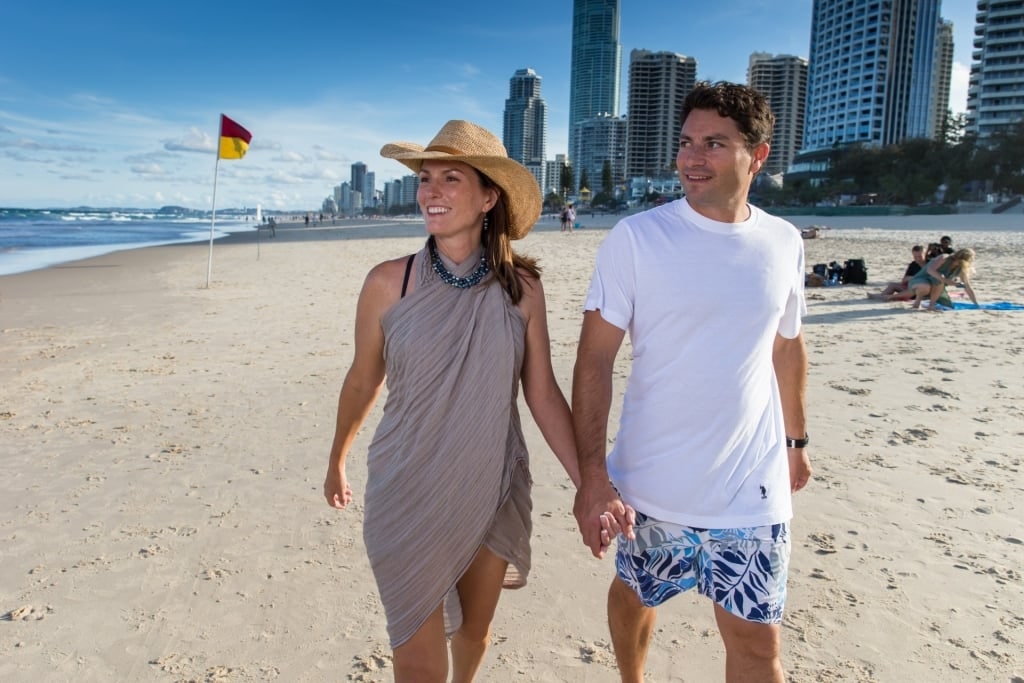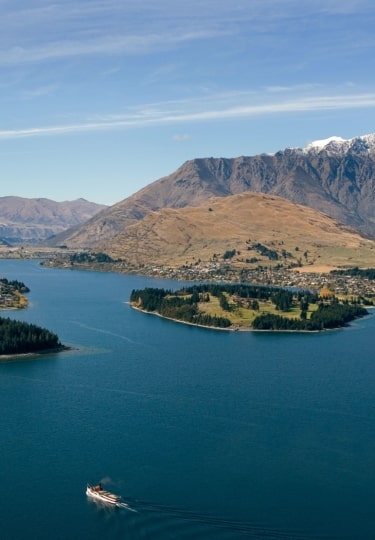The best time to visit Australia and New Zealand, where the seasons are reversed from those in the Northern Hemisphere, is the spring, summer, and early fall, between November and April. This is a time for enjoying mountains, vineyards, and rainforest, admiring wildlife, exploring magnificent beaches, and taking in the culture of some of the world’s most dynamic cities.
Both countries have enormous variations in temperature and weather, so the best time to visit Australia and New Zealand really depends on where you want to go in this vast, exciting, and highly diverse region.
Visiting Australia & New Zealand by Season
Summer

Gold Coast, Australia
Summer in Australia falls between December and February. Days are hot and sunny, with often high humidity the further north you go. Australia Day, on January 26, is a fantastic time to be in Sydney, with celebrations around the famous harbor.
Temperatures vary during these months from average highs of 78.8°F (26°C) in January in Melbourne and Sydney to 71.6°F (22°C) in Hobart, which is much further south. In Queensland, in contrast, the summer months bring intense humidity and heat, the rainforests lush and green, waterfalls in full flow, wildlife active, and juicy tropical fruits in season.
New Zealand’s summer is shorter, as it’s much further south. Expect long, sunny days and pleasant temperatures ranging from 67°F to 77°F (20°C to 25°C), depending on where you go. This is a season of barbecues, beaches, whale watching, and hiking in New Zealand, and a time when Kiwis make the most of the beautiful weather.
Fall
March, April and May are the fall months and the start of the dry season, with long, sunny days and pleasantly warm nights. This is a great time to visit for the grape harvest, and in the mountains, the brilliant hues of the fall colors.
Expect temperatures in Sydney of around 58.3°F to 72°F (14.6°C to 22.2°C). Melbourne is cooler, with fall temperatures ranging from 51.6° to 68.5°F (10.9 to 20.3°C) and occasional morning fog.
In the north, the rainy season is coming to an end and the humidity is less intense.
Fall in New Zealand also extends from March to May, with fewer visitors and generally sunny days, particularly in the north. Temperatures range from 64.4°F to 77°F (18°C to 25°C), depending on where you visit.
This is a time for taking in the magnificent fall colors and visiting New Zealand’s wine regions to sample their wares as the vines turn golden.

Cloudy Bay, New Zealand
Winter
The Australian winter is June, July, and August. Days are shorter, with frost in the far south and snow on the mountains in both New South Wales and Victoria.
Melbourne’s winters are cool, dropping to average daily highs of 57.2°F (14°C) in June and July, with Sydney slightly warmer at 62.6°F (17°C). This is when rainfall is highest and the days shortest.
New Zealand’s winters are much colder, especially in the Southern Alps, which enjoy a celebrated ski season. The North Island, meanwhile, is wetter and milder.
Spring
Spring, during the months of September, October, and November, brings wildflowers and mild weather. It is a wonderful time for outdoor activities and hiking in some of Australia’s most beautiful places.
Wildlife is more active, too. You could spot kangaroos and koalas with their young (“joeys” in both cases). If you’re in Melbourne in November, prepare for the whole city to stand still for the annual Melbourne Cup horse race, one of the most prestigious in the world.
In Australia’s north, this is the beginning of the rainy season, with increased humidity and a higher likelihood of short, sharp tropical showers in the mornings and evenings.
Spring in New Zealand brings cool days and a chance of rain, but wonderful hiking conditions; you’ll see lambs in the fields and yellow daffodils everywhere.
Temperatures rise more quickly in the North Island than they do in the South. By November, Auckland is enjoying average highs of 68°F (20°C).

Dunedin
When Is Rainy Season?
Rainy season in Australia varies from north to south. In Queensland, the rainy season is from October to March, with the most intense rainfall between January and March; February can see an impressive 19.3 inches (491 mm) in Cairns.
You can still visit the Great Barrier Reef during these months, though, and snorkel over dazzling corals.
Elsewhere, rainfall varies dramatically. In Melbourne, October to December is the wettest period, with May a close second, receiving an average of 2.75 inches (70 mm) of rain. In Sydney, June is the wettest month, with an average of 5.2 inches (132 mm) of rainfall.
In New Zealand, the rainy season is from May to August, with precipitation falling as snow on higher ground in the South Island.

Great Barrier Reef, Australia
When Is High Season?
High season in Australia is the peak of summer, from December to February, when days are long, hot, and dry, and locals head for the beaches. An exception is the north, which is in the midst of its wet season during these months.
Peak season in Queensland is the Australian winter, although plenty of people still visit in the humid summers for the Great Barrier Reef, the national parks, and the lush rainforest.
New Zealand also has its finest weather between December and February, and as such, the most visitors during these months. The summer season is much shorter here, though, as New Zealand is much further south.
When Is Shoulder Season?
Shoulder season in Australia is spring and fall, both of which have a great deal to offer. Fall is one of the best times to go to Australia and New Zealand to enjoy the wine harvest, the beautiful fall colors, and fresh, sunny days.
Spring is a great time for coastal hikes, city sightseeing, and outdoor dining.
Shoulder season in New Zealand is a wonderful time to visit, whether you come in spring for the lambing season and wildflowers, or fall for the wine harvest and days that are still long and warm.
When Is Low Season?
Cities like Melbourne, Sydney, Hobart, and Adelaide are buzzing with life year-round and are so packed with cultural activities that there is no bad time to visit. The low season, though, is the winter months, from June to August.
Low season in Queensland is the summer, from December to February. There’s more rain, although there are still plenty of compelling reasons to visit during this time.
Low season in New Zealand is the winter, unless you’re a skier. Days are short and rain is common.

Sydney, Australia
For the adventure of a lifetime Down Under, browse Celebrity’s Australia and New Zealand cruises and plan your great escape.


